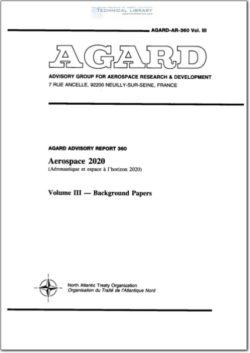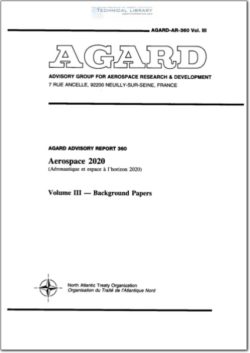AGARD-AR-360 Vol 3

- Version
- 65 Downloads
- 7.17 MB File Size
- 1 File Count
- March 8, 2016 Create Date
- March 8, 2016 Last Updated
Aerospace 2020 - Background Papers

Summary: Many of the pilots who will be flying in
the year 2020 are just now being born or are
currently very young children. We will know more
about these pilots than we presently know about our
current pilots The air forces of the future will surely
include many more women as they will likely
compete on an equal footing and may be represented
in all cockpits. Efforts currently underway,
including Neuropsychiatrically Enhanced Flight
Screening, Assessment of Psychological Factors in
Aviators and Psychological Factors of Aviators‘
Success may bear fruit and answer the question of
whether female pilots self-select into aviation or if
they are shaped as a result of the process of pilot
training. The year 2020 may see the Armstrong
Laboratory Aviator Personality Survey as a well
established test for use with aviators, with
international norms. As we invest increasingly large
amounts of money into each individual airframe and
mission, we must learn more about the human
operator, whether that individual is a pilot or a
controller of a pilotless aircraft or spacecraft
(Uninhabited Aerial Vehicle),
Introduction: The human side of the man-machine
equation is currently considered the more
unknowable, despite the urgency of human factors
which contribute to perhaps 75% of aircraft
mishaps. Traditionally, when aircraft technology
outstrips the ability of the human operator to
function in the aerospace environment, the
technology is scaled back to accommodate the
human. The challenge for aerospace researchers
today and in the future is to help the human operator
keep up with, or even ahead of, the burgeoning
technology.
Text: We will know more about future pilots than
we know about pilots flying today. The
Neuropsychiatrically Enhanced Flight Screening
program (N~EFS, I) specifically addresses the need
for pilot selection beyond more medical
qualification. By the year 2020, N-EFS will have
collected cognitive and personality-functioning
information on in excess of 30,000 pilot candidates
and will have follow-up occupational outcomes for
the candidates who successfully complete
Undergraduate Pilot Training. The objective of this
flight screening program is to obtain longitudinal
psychological testing data and then compare the
results to actual performance when the trained pilot
has been mission-tested.
| File | Action |
|---|---|
| AGARD-AR-360 Vol 3 Aerospace 2020 - Background Papers.pdf | Download |

Comment On This Post